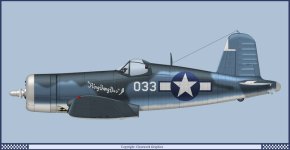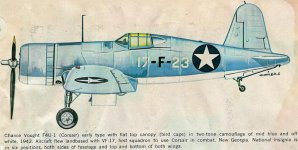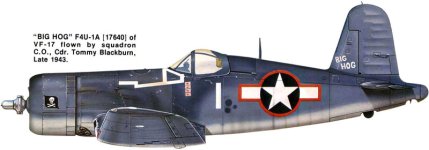kelticheart
I will look into it but my guess is that even the early one where retrofitted in the field.
Oh yes, definitely.
Early F4U1s, not yet "war weary", were field-retrofitted with bubble canopies, left wing leading edge spoilers and softer shock absorbers to correct the U1 tendency to bounce upon touch down, with resulting blown tires and smashed wheel rims.
Yet, this would make a F4U1 upgraded to a U1-A and not a "dash A" turned into a U-1, with raised cockpit and rear fuselage plus a birdcage canopy. Which is what your rework shows.
The attached profiles from Wings Palette show very well the differences in fuselage/cockpit height and taper angle between the F4U1 and the U1-A. It's subtle, but it's there.
Allen, I am bothering you with this only because your works are all top notch. A detail like this would only improve your new Birdcage Corsair, keeping the high quality of your reworks above any possible criticism.
This model is a "must have" to fill a niche in the defence of Guadalcanal missions with a framerate efficient historical aircraft that was indeed there.
One thing I forgot to mention yesterday is that, contrary to popular beliefs, the F6F Hellcat was the interim fighter plane for the US Navy, while waiting for the F4U1 Corsair ironing out of all new design defects. Not the other way around.
According Ltnt. Cdr. Blackburn (2nd profile from the left), Chance Vought had started developing the Corsair long before Grumman thought of a new Zero destroyer to replace the inferior Wildcat in front line units.
Unfortunately, the Corsair took longer than expected to become a reliable front line, carrier based fighter. And this because technologically it was superior than the Hellcat, which was taken off Grumman production lines immediately at the end of WWII, while the Corsair remained in production well in the 1950's.
Cheers!
KH 






